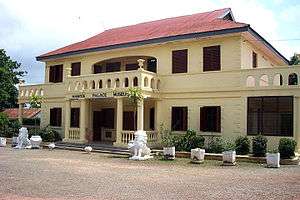Manhyia Palace
The Manhyia (Akan language meaning Oman hyia - gathering of the people) Palace is the seat of the Asantehene of Asanteman, as well as his official residence.[1] It is located at Kumasi, the capital of the Ashanti Kingdom and Ashanti Region. The first palace is now a museum. King Opoku Ware II built the new palace, which is close to the old one and is used by the current Asantehene, King Osei Tutu II.

History
The palace was built in 1925[2] by the British some time after the Third Anglo-Ashanti War in 1874, when the British had destroyed the original palace built by Asantes. The British were said to have been impressed by the size of the original palace and the scope of its contents, which included "rows of books in many languages.",[3] but due to events in the War of the Golden Stool, the British demolished the royal palace with explosives.[4] The palace consequently erected is a kilometre from the Centre for National Culture, Kumasi.
Upon the return from exile of the Asantehene Nana Prempeh I from the Seychelles Islands, the building was offered to him for use as his residence. This was because prior to the Asantehene's exile, his old palace had been burnt down in the Yaa Asentewa War.[5] The war was fought between the British and the Asantes because of the refusal of the Asantehene to offer the Golden stool to the then governor of the Gold Coast. Prempeh I only accepted the offer after he had paid for the cost of the building in full.[5] Two kings lived in the palace, namely Otumfuo Prempeh I and Otumfuo Sir Osei Agyeman Prempeh II, KBE, the 13th and 14th kings of the Asante nation.
The old palace was converted into a museum in 1995 after the new palace was built. Opoku Ware II was the first king to live in the new palace, which he occupied until his death in 1999. The current Asantehene Barima Kwaku Duah popularly called Otumfuor Osei Tutu II, currently resides in the new palace.[5]
Major activities
The palace courtyard hosts numerous important Asante traditional events. These include the Adae festival, which occurs every sixth Sunday, when the Asantehene receives homage from his subjects and subservient chiefs.[5]
Manhyia Palace Museum
The palace built by the British after the "War of the Golden Stool"(Akan Language "Sika" = Golden stool ="Dwa") was converted into a museum and official opened on 12 August 1995[5] by the then king, Otumfuo Opoku Ware II. The opening of the museum was part of activities that marked the Silver Jubilee of his accession to the Golden Stool.[5] This palace was used as the office of the Kings. It served as Administrative headquarters of Asante Nation from 1925 to 1974 until Otumfuo Opoku Ware II moved from this office to the new residence at Manhyia.[5] Several artefacts are displayed in the museum. They include furniture used by the Kings, the bronze head of Nana Sir Osei Agyeman Prempeh II, and a sketch map of the Asanteman.[5][6] There is also Asanteman's first television[2] at the museum, as well as life-sized wax effigies of some of the kings and queens of Asanteman.[5]
Architecture
The architecture of the palace is akin to the Kingdom of Asante building plans of the early 1900s. The palace is a two-storey building.[5] Both floors have open verandas, giving a view of the palace's environs. In 1995, an outbuilding was added to the original palace to serve as a gift shop.[5] The palace has a large courtyard and it showcases statues of past great kings and queens of the Ashanti.[5]
References
- "Manhyia Palace". Ghana Nation. Retrieved 9 May 2011.
- "Manhyia Palace Museum". lonelyplanet.com. Retrieved 9 May 2011.
- Lloyd (1964), pp. 172–174, 175
- Raugh, Harold E. (2004). The Victorians at War, 1815–1914: an Encyclopedia of British Military History. ABC-CLIO. ISBN 9781576079256.
- "The Museum". manhyiapalacemuseum.org. Archived from the original on 11 May 2011. Retrieved 9 May 2011.
- Asanteman is the Asante translation of the Asante Kingdom
External links
![]()